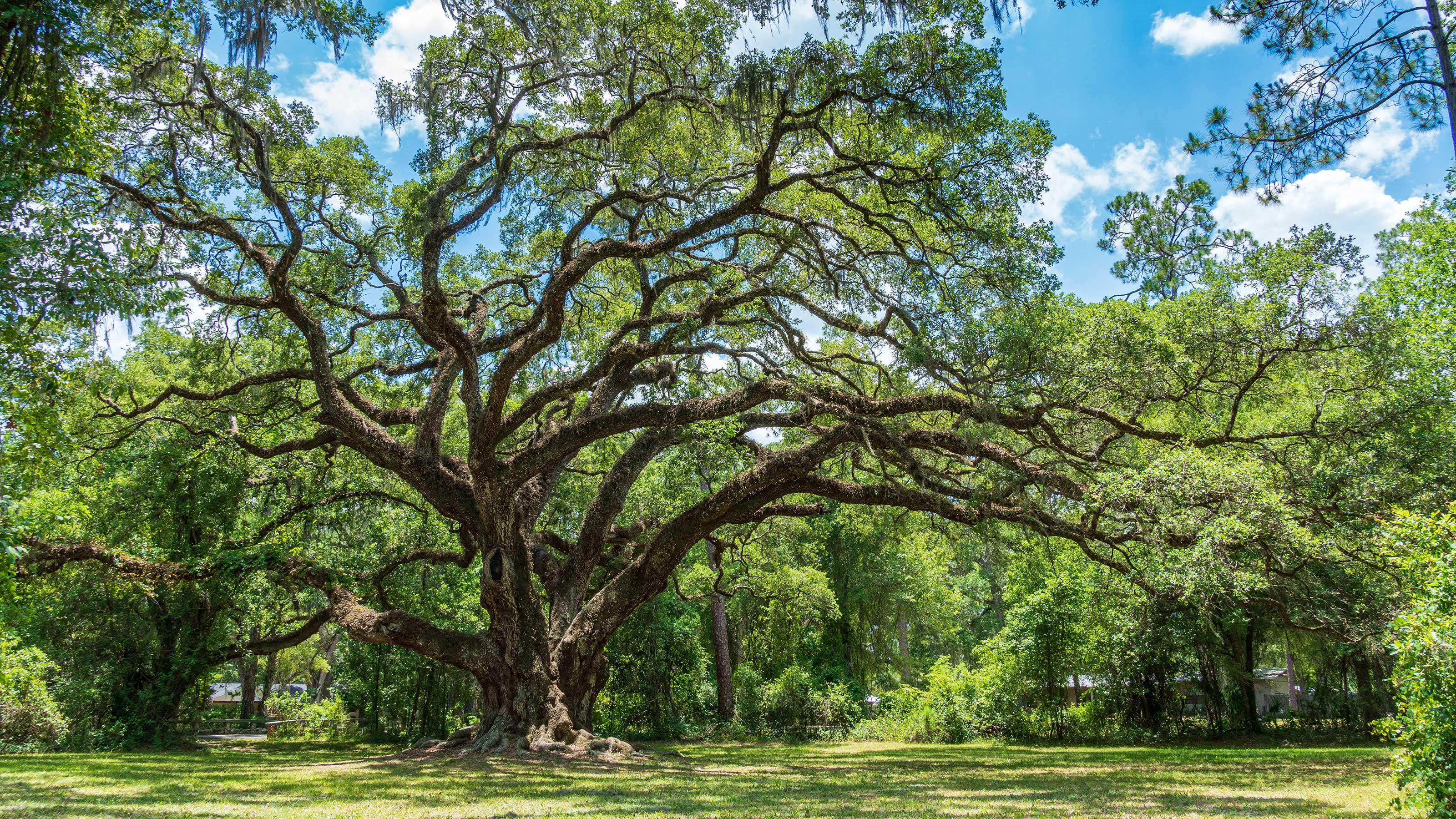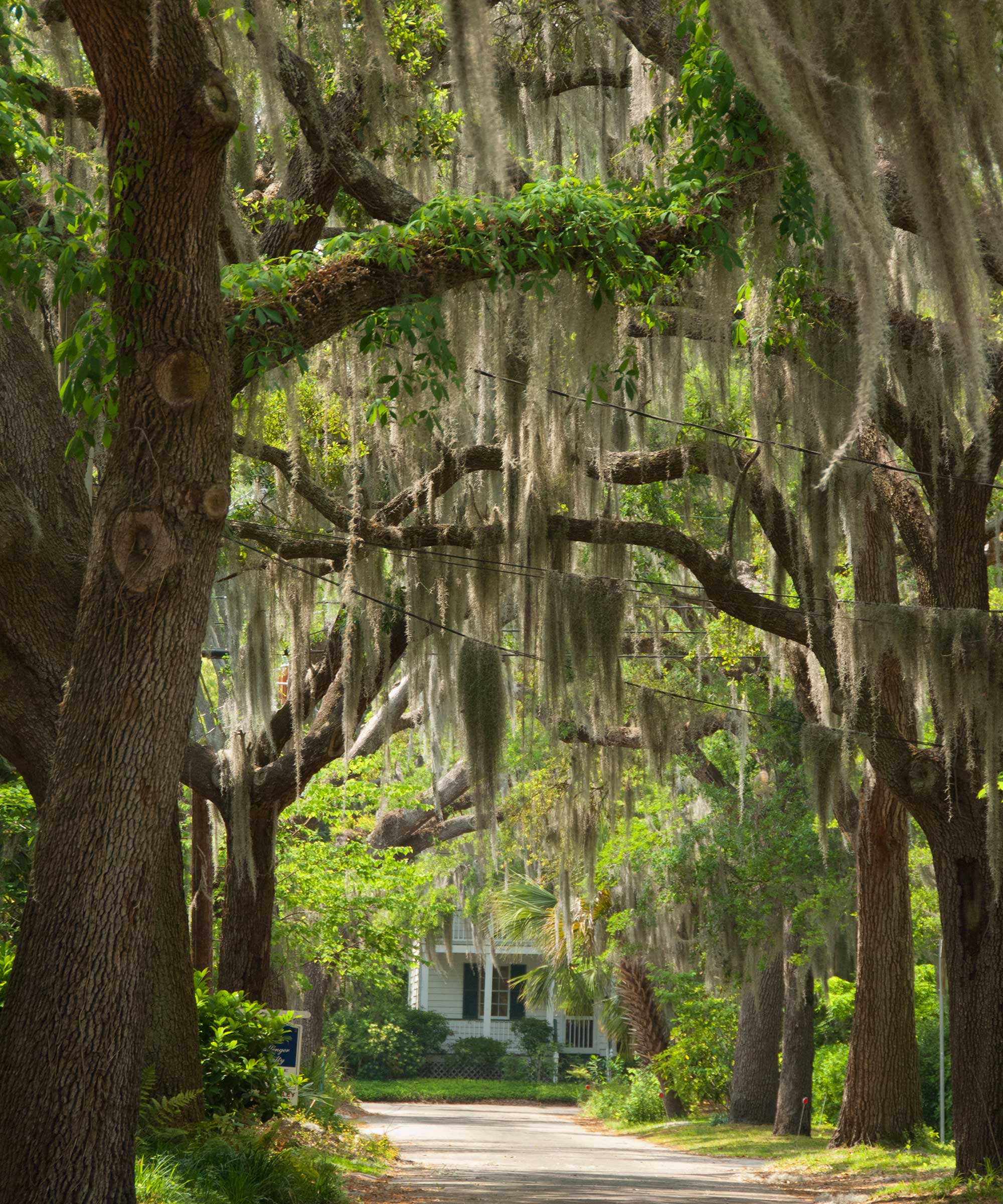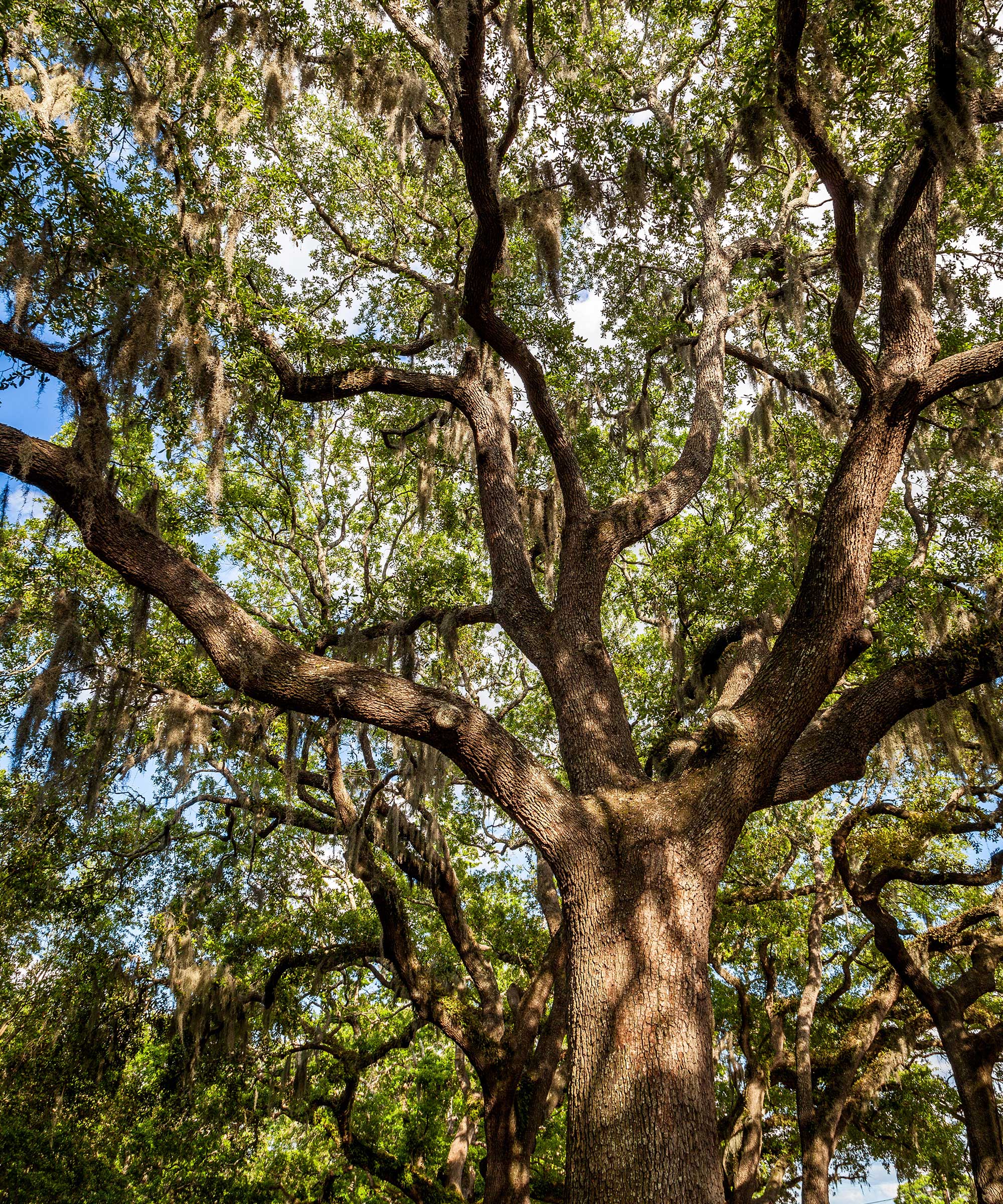Live oak care and growing guide: tips for these majestic trees
Learn how to grow a live oak in your backyard for shade and structure


The sprawling, moss-clad branches of a live oak, Quercus virginiana, make a dramatic and very picturesque statement. It’s one of the longest-lived oak trees and there is no doubt that a mature, centuries-old live oak has a theatrical quality.
Live oaks are very much associated with the ‘Old South’. It’s also known as the Southern live oak and is the state tree of Georgia, but is a very common sight across the lower-lying areas of many of the southern United States, both inland and along coastal areas. You might see live oaks planted as a statuesque solo specimen mid-lawn, with plenty of room for the wide, super-spreading branches, or lining long avenues or city streets.
If you want to grow this in your backyard, you'll need plenty of space. Its trunk grows to a diameter of 6ft (2m) and its branches spread to give it a breadth of up to 100ft (30m). Being a native tree, in the right local conditions it will thrive and live a long life. It’s naturally also great for supporting native wildlife.
The live oak is an evergreen tree, holding on to its dark, waxy leaves until spring, when new growth takes over – and that’s when any yellowing old foliage will drop. It’s also home to mosses and ferns that will grow symbiotically along the spreading branches, which add to its charm.
Sometimes confused with the water oak, Quercus nigra, the live oak is more suited to a wide range of soils, but won’t tolerate growing in cooler, more mountainous areas. It will only reach its majestic full size in the warmer, humid, low-ground areas that are its most natural habitat.
Live oak: key facts
- Plant type: Large, evergreen tree
- Mature size: 40-80ft x 100ft (12-24m x 30m)
- Soil type: Most soils, from dry to damp
- Soil pH: Acid-neutral
- Time of year to plant: Summer or fall, depending on your region
- Flowering time of year: Spring
- Flower color: Yellowish catkins
- Hardiness zones: USDA Zones 8-10 (UK H4)
- Scientific name: Quercus virginiana
- Common name: Live oak

Types of live oak
There are not many cultivars deriving from the parent species Quercus virginiana. We have listed four below.
- ‘Highrise’ – this was the first commercial live oak cultivar. It has been bred for a more compact and upright habit. It’s therefore far more suitable for smaller backyards and landscapes and is more widely used for street planting. It grows to around 40ft (12m) in height and spreads to 18ft (12m).
- ‘Cathedral’ – also a more compact cultivar, this has a more spreading habit, like the species live oak, and it makes a useful tree for shade and privacy in larger gardens or public landscapes. Trees average 35ft (10m) in height with a maximum spread of 20ft (6m).
- ‘Millennium’ – with larger leaves and a thicker trunk and branches, this cultivar is very similar to the parent plant and will reach a maximum height of 75ft (22m) and spread of 100ft (30m).
- 'Sky Climber' – a full-size live oak with an upright habit and dense, rounded crown, reaching a maximum height of 80ft (24m) and a full-size spread of 100ft (30m). One for large gardens.
Other named cultivars include 'Parkside', 'Boardwalk', and 'Augustina'.
According to the experts at Clemson Co-operative Extension, part of the Clemson College of Agriculture Forestry and Life Sciences in South Carolina, over the years, related species such as the Cuban live oak and dwarf live oak have been classified as Quercus virginiana varieties, but these are now considered species in their own right.
A related species, Quercus fusimormis, known as the Texas live oak, is found in central Texas and tends to be smaller and multi-stemmed in form.

How to use live oaks in a backyard
Live oaks are great trees for providing natural shade for gardens during the heat of summer. The experts at Southern Pride Tree Farm say: 'The live oak tree is perfect for any landscape application where the natural beauty of the live oak is desired. Our live oak trees are found in parks, front yards, backyards, commercial applications such as building landscapes, parking lots, and more. Live oak trees in the south are often desired for natural shade that protects and cools a home from the sun.'
When choosing this tree for your backyard, bear in mind that you'll need space for it to grow. They are well-suited to a large, lawned area. If planted very near houses and paved areas, the extensive roots can cause damage in the long term.

When, where and how to plant a live oak
The ideal conditions for planting a live oak are a site in full sun, with well-drained, sandy soil and plenty of moisture. However, these are tough trees and will tolerate less-favorable, drier, more compacted soils. Once established, the live oak has proven to be a surprisingly drought-tolerant tree and will also cope with some shade.
In the optimum conditions, in coastal areas, a live oak will put on growth of up to 2.5ft (80cm) per year, slowing down as the tree matures.
Emily Marois, the Urban Horticulture Extension Agent and Master Gardener Coordinator for the University of Florida/Institute of Food and Agricultural Sciences (UF/IFAS), advises: 'The time of year to plant depends on the region that the tree will be planted. In South Florida, summertime is ideal for establishing trees and shrubs due to the ample rain and humidity. In temperate regions, typically, fall is the best time of year. Your local Cooperative Extension (US) will be able to tell you when it is ideal to plant in your area.'
To plant, prepare a hole wider than the rootball of the tree. Remove some of the outer roots and place the tree in the hole, adding a stake if required, with the ‘root flare’ that appears at the base of the trunk just slightly above the surface of the soil. Backfill and water in well, adding a thick mulch on the surface, around the base of the tree.
Keep young trees well-watered until they are firmly established. You can remove the stake around 12 months after planting.

Live oak care tips
To keep the tree as healthy as possible, plant the tree correctly and water it often until it’s well established.
Other than that, they are pretty low-maintenance trees. Add a light mulch and feed if necessary. Remember to water during periods of dry weather. Some pruning is also required (see below).
How do you prune live oaks?
Emily Marois advises: 'Due to this tree’s ability to live for many years, it is imperative that the tree is pruned to achieve proper structure early in its life.
UF/IFAS recommends that a live oak is pruned every year for the first three years (typically in the nursery setting), then every five years until it reaches 30 years old.
Proper pruning will allow the tree enough clearance from the ground, can prevent breakage during storms, and reduce the potential for decay. A certified arborist will be able to properly prune these trees.'

How to make more live oaks
Live oaks can be propagated from the acorns produced by the tree. You can also take semi-hardwood cuttings from these plants.
Common problems with live oaks
Live oaks are largely pest and disease-free in most areas.
They are prone to leaf blister, powdery mildew and canker, but these don’t do much harm to the tree. You can manage these diseases by removing and destroying any leaf litter.
However, live oaks can also be affected by oak wilt, a serious fungal disease that can be fatal. It has been reported as affecting red, black and live oaks in Texas and a few other isolated areas in South Carolina and can kill trees within a few years. Removing and destroying any infected trees is the recommended course of action.
Care should be taken with cleaning pruning tools to prevent any spread of disease. Live oaks are also not immune to honey fungus.

Is live oak poisonous?
Yes, as well as being toxic to humans, the live oak is a poisonous plant to dogs, horses, cattle, sheep, and goats.
The toxins are found in the buds, flowers, young shoots and acorns, but not in the mature foliage, so care should be taken not to allow animals to graze near live oaks, particularly in spring and autumn.

In her years of gardening, Camilla has designed planting schemes for gardens large and small in and around London, written about plants and how to grow them, and worked on BBC gardening TV shows. She's passionate about sharing tips, advice and the joy of plants in this great community of gardeners that we’re all part of, and she now also works as a therapeutic horticulturist, teaching growing for wellbeing and mental health. Her unfulfilled ambition is to crack the ultimate dog-friendly garden - she thinks getting it right depends more on the dog than the plants...
